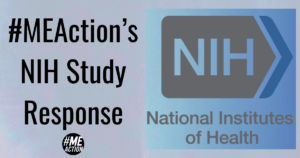 Phoenix Rising’s Mark Berry was at the recent Invest in ME conference and has written an excellent report:
Phoenix Rising’s Mark Berry was at the recent Invest in ME conference and has written an excellent report:
A New Decade of ME Research: The 11th Invest in ME International ME Conference 2016
As the article is quite long, here are some tasters (my summaries, with quotes from Mark’s article) to whet your appetite for the feast, which concludes with Professor Ron Davis’s talk.
You can click on the titles to go direct to the relevant section in Mark’s report.
Dr Vicky Whittemore hails ‘new dawn’ at the NIH for ME/CFS — Dr Vicky Whittemore
Whittemore acknowledged historical problems at the NIH, such as the “shocking and disappointing” funding levels and outlined the NIH’s emerging agenda for the illness including the ‘deep dive’ intramural study.
‘She said that her “hope and vision” was to return to IiME in the next two years and present a graph showing levels of government funding for ME/CFS research “off the charts.”’
Clinical Diagnosis of Myalgic Encephalomyelitis – Professor Olli Polo
Professor Olli Polo talked about how he diagnoses ME/CFS, and said that symptoms affect the whole of the sympathetic trunk, making ME/CFS a whole-body condition that doesn’t fit well with the prevailing model of medicine. He also said that many of his patients had signs of connective tissue disorders.
Autoantibodies to neurotramsimtter receptors in CFS/ME– Professor Carmen Scheibenbogen
Scheibenbogen reviewed the evidence for autoantibodies playing a role in ME/CFS, and discussed her recent finding that patients had more autoantibodies than controls against two types of neurotransmitter receptors: beta-adrenergic and muscarinic acetylcholine receptors. She noted that stimulation of these receptors could cause familiar ME/CFS symptoms.
Her research also found that responders to rituximab in the Fluge and Mella trials had reduced levels of these antibodies after treatment, while this wasn’t seen in non-responders.
Immune regulation in patients with ME – Dr Jo Cambridge
Cambridge worked with Professor Jonathan Edwards to develop rituximab as a treatment for rheumatoid arthritis, and got involved in ME/CFS research following those promising rituximab pilot studies in Norway.
She discussed how rituximab works in various autoimmune diseases. It kills most B cells and may work in ME/CFS either because it stops B cells turning into the antibody-producing factories called plasma cells (cutting off supplies of autoantibodies), or through stopping the interaction between B cells and T cells, which are another key type of immune cell.
PhD student Fane Manseh, who works with Cambridge, presented his work studying ME/CFS patient B cells in the lab, looking at what controls their development and antibody production, and how they interact with T cells.
Gut Virome in ME – Professor Tom Wileman
You’ve heard of the gut microbiome, and the gut virome is part of this: it’s all the viruses that infect the bacteria in the gut (“Every flea has a flea that lives on a flea”). Interactions between the gut microbiome and the body can affect inflammation, and the ‘Virome hypothesis’ says that the gut virome can play an important part in triggering this inflammation leading to disease.
Wileman has studies the virome in IBS, and found that reduced diversity in the virome (fewer different types of virus than normal) is linked to IBS. The virome may provide a biomarker in diseases, including ME/CFS.
Invest in ME-sponsored PhD student Daniel Vipond is currently exploring the gut virome in ME/CFS patients.
Receptors and intracellular signalling – Professor Don Staines
Staines, of Griffith University, discussed the team’s recent work on receptors that play an important role in cell signalling. Their previous research had identified an association between a genetic variant of the ion channel receptor, TRPM3, and ME/CFS. When the TRPM 3 receptor is activated, it briefly lets calcium into the cell, which is a common way the body uses to send a signal.
Recently work from the group showed patients had reduced levels of the TRPM3 receptor in B cells and natural killer cells, which together with the genetic variant may affect cell functioning: they found reduction in calcium levels within cells. Staines said his group believe that ion channel receptor function, and calcium signalling problems, could be causing ME/CFS.
Staines said they have many more papers on this subject to follow.
New European research networks launched — Professor Simon Carding
Professor Simon Carding introduced EMERG, the European ME Research Group that was launched last autumn. It’s a network of research groups which aims to jointly define a co-ordinated research strategy. EMERG is already working to improve research with expert groups looking at clinical diagnosis and stratification, biomarkers and standardising how different research groups prepare samples.
A separate network, EUROMENE – for individual researchers rather than research groups – was launched in Easter this year and has secured 6 million Euros in funding. EMERG and EUROMENE have already met up and will work in complementary ways.
Early feasibility projects are looking at infectious origins (environmental and microbiome alterations), and clinical trials and supporting research (e.g.,rituximab).
Pathogen Discovery in ME – Dr Mady Hornig
Hornig explained how the group at Columbia University are working to identify pathogens and triggers for ME/CFS.
“Much of her wide-ranging and complex presentation aimed to explain why her group’s model of ME is an immune-mediated brain disorder, with a significant connection to the gut. When the microbiota (gut microbes) are disordered, disorders of brain function are among the many consequences.”
Changes in the gut microbiota could trigger autoimmunity, she said, and also have an effect on the brain, for example by affecting the levels of tryptophan, a molecule that’s needed to make some neurotransmitters (infections can affect tryptophan levels too). In short: it’s complicated.
The Search for Biomarkers for Myalgic Encephalomyelitis – Professor Maureen Hanson
Hanson talked about her study with Susan Levine using 49 ME/CFS patients to search for biomarkers in the gut microbiome. They’ve made two interesting findings. The first is a big increase in blood lipopolysaccharide, LPS, which could be due to bacteria or bacterial breakdown products from the gut crossing into the blood. The second finding is a shift in microbiome profile, with more bacterial species reported to be pro-inflammatory, and fewer bacteria reported to be anti-inflammatory. There was also a “loss of species richness” i.e. fewer different types of bacteria in patients. The microbiome profile has potential as a biomarker, she said, and her group will do more work to develop its potential.
Hanson commented it was hard to square these findings with a psychosocial model of ME/CFS.
Molecular Biomarkers of Myalgic Encephalomyelitis — Professor Elisa Oltra
Professor Elisa Oltra is looking for biomarkers among microRNAs, small RNA molecules that play a key role in regulating gene expression that have been established as proven biomarkers of other diseases, she said. Her group have already found microRNAs with biomarker potential in a small study of Fibromyalgia patients who also had ME/CFS, and they are working on a replication in a larger sample of patients.
Exercise Testing and Orthostatic Tachycardia – Professor James Baraniuk
Baraniuk reviewed the changes in diagnostic criteria for ME/CFS, fibromyalgia and Gulf War Illness. He noted that fibromyalgia criteria had ‘drifted’ from the original versions, as had ME/CFS, but he praised Carruther’s focus on the key ME/CFS symptom of post exertional malaise in later criteria. Baranuik shocked the audience when he said that Gulf War Illness – a major focus of his research – affects 25-32% of those deployed. Many had been exposed to chemicals.
Baraniuk’s current ME/CFS study uses an MRI brain scan before and after a submaximal exercise test and early results from this unfinished study show changes in brain blood flow, especially after a cognitive test. Patients also show greater activation of the sympathetic ‘flight or fight’ nervous system than controls, and half of patients had postural tachycardia – a racing heart when they stand up, which may be linked to reduced blood flow.
Big Data Approach: Severely Ill ME Patient Cohort – Professor Ron Davis
Invest in ME had saved the best til last: “Davis delivered a mind-blowing presentation that drew the day’s longest round of applause by far.”
Most people know that Davis is motivated by finding effective treatment for his son who’s very severely-affected. Davis was part of the IOM panel reviewing 9,000 publications and he said he found little useful biomarker data so decided to collect his own, teaming up with the Open Medicine Foundation to raise funds for a small but intense study. The study costs $70,000 a patient, even with many companies providing their services at greatly reduced because of the esteem in which they hold Davis (several are run by former students).
While the study is small, with only 25 patients, Davis said focusing on the severely-affected who have a ‘larger molecular signal’, together with looking at many potential biomarkers simultaneously, increases the odds of finding biomarkers. Any promising biomarkers will be validated in larger groups of patients.
Davis has some results in already, and the early findings are dramatic: they are….
… well, you’ll just have to read Mark’s account to find out. It’s well worth it.
Mark wrapped up his excellent account with personal reflections on the conference: he’s excited that things seem to be coming together at last in ME/CFS research.
There are shorter, but less detailed write-ups from Dr Charles Shepherd of the ME Association, and Dr Rosamund Vallings for Invest in ME itself. Buy the Invest in ME conference DVD.
Save
Save
Save





